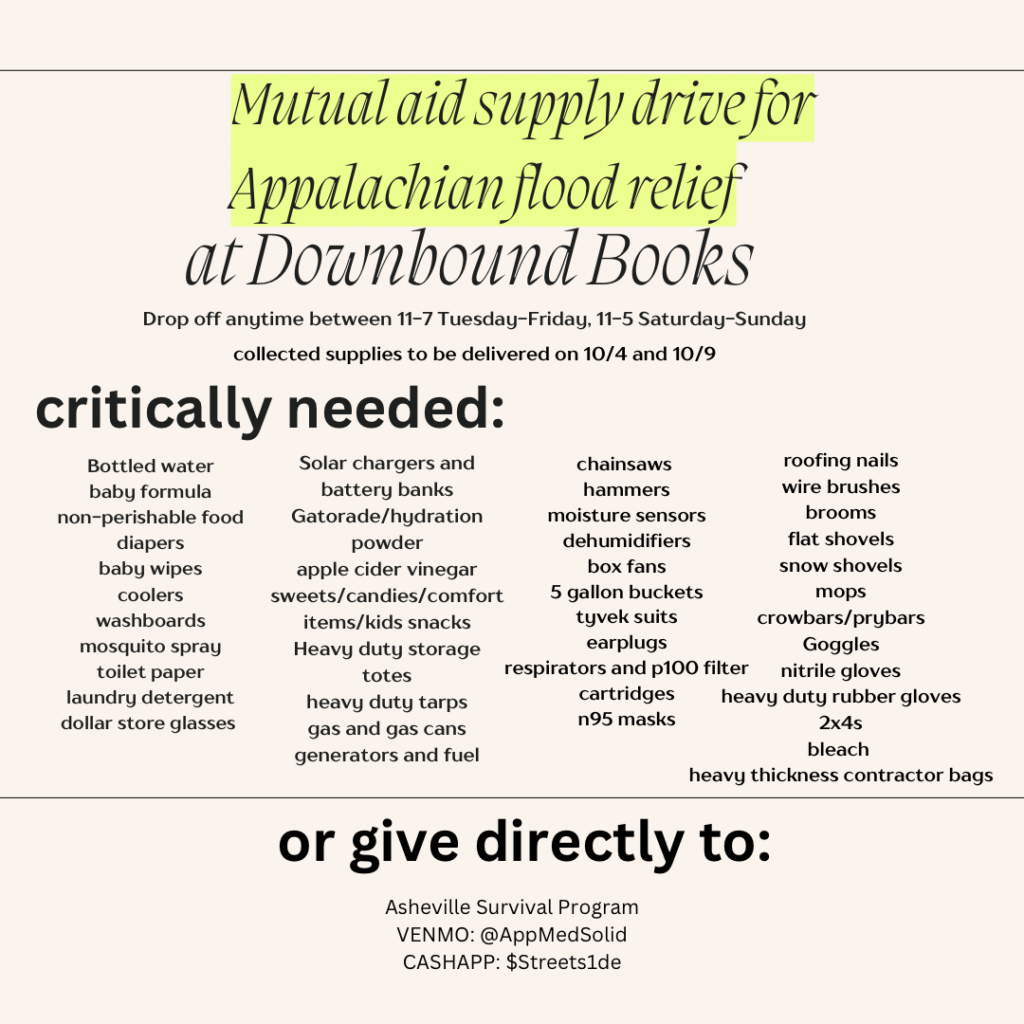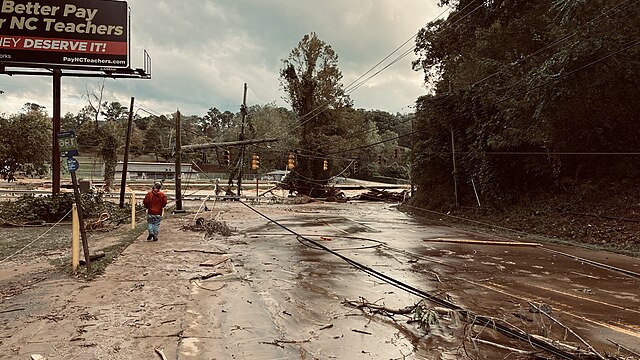By Mike Templeton
Cover Photo By Bill McMannis / Source
It just does not seem possible that we would be posting an article on devastating flooding in the Appalachian region just as we co-sponsored a celebration of the release of Troublesome Rising: A Thousand-Year Flood, a collection of writings and art that commemorates the flooding in Eastern Kentucky. Yet here it is, and the Appalachian region has been devastated by floods in the wake of Hurricane Helene. Just as we did when the floods hit Eastern Kentucky, the Urban Appalachian Community Coalition is deeply committed to helping flood victims in any way we can. Many urban Appalachians have family and friends in places effected by the flooding after Hurricane Helene, and the desire to help our neighbors is just a fact of who we are.
What has happened did not seem possible for many people. The extent of the rain and flooding is unprecedented. Annette Saunooke Clapsaddle is a North Carolina writer who was at the Appalachian Writers Workshop in Hindman, Kentucky, for the 2022 floods. In an article in The Atlantic, she writes that she and others imagined that places like Western North Carolina were not susceptible to flooding in the ways Eastern Kentucky is because these more southern mountains “had not been lopped off for strip-mining by coal companies, the lack of vegetation allowing walls of water to cascade down them unrestricted.”
But these assumptions proved to be incorrect, and Clapsaddle provides us with some nightmarish images as she explains the facts of life in the affected areas: “As I write this, I don’t know how all the cities and towns of western North Carolina are faring. I know that gas is scarce, and still none of us has reliable cellular or Wi-Fi service. I know that the Dollar General is out of eggs. I know that rockslides cover some roads and many others have crumbled. I know that the hospital in Cherokee cannot send patients to Asheville’s Mission Hospital for critical care. I know that homes are gone and lives are gone.” Every aspect of life is impacted by the floods, and the needs of people in these areas are immediate.
AP News reported that the extent of the floods was due to an extremely rare combination of storms. Local storms combined as Hurricane Helene made landfall and made its way inland. According to meteorologists, these conditions dropped “40 trillion gallons through Sunday for the eastern United States, with 20 trillion gallons of that hitting just Georgia, Tennessee, the Carolinas and Florida.” It is just about impossible to wrap our minds around rainfall of this magnitude. Entire roads are gone, leaving people stranded. The rural areas and small towns, always more vulnerable than urban areas, are completely cut off, and in some places, supplies are being brought in on horseback and on mules. Electricity, water, and cell service are all interrupted.
Our friends have offered perspectives to help us understand just how horrifying the conditions are in the aftermath of the flooding. Jessica Cory is the Editor for Appalachian Journal and a resident of Wilkes County, North Carolina; she told us: “Here in the High Country, roaring rivers have sucked chunks of cement and tar into their churning depths, have transformed dirt and gravel roads into sweeping streams, and have relocated barns and other structures miles from their original locations. With all of this water, however, many of my friends, neighbors, and colleagues are without, since wells are the norm and require electricity to run, and so much infrastructural destruction inevitably leads to water line breaks. A quick trip to Lowe’s reveals generators and dehumidifiers filling up the carts of those lucky enough to exit their driveways, and the aisles of my local Walmart, thirty miles down the mountain from Boone, show a high demand for bottled water and personal hygiene wipes. The center aisle displays at this particular Walmart are stacks of camping propane canisters and coolers. I want to believe that these displays were there a week ago, enticing leaf-season campers, or that maybe the idea was to make these necessities easier to find for those in need rather than to make a quick buck on this regional tragedy and further exploit the many of us who are already suffering.”
The need for supplies is obviously urgent. Things we do not often think about in urban areas is just how easily access to drinking water can stop in the rural parts of the country. Once the electricity is cut, the wells stop working, and people cannot get water. Same goes for sewage and waste treatment.
The focus now is to get relief and assistance to the people who need it. There has been a lot of media attention focused on areas like Ashville and other urban areas, and no one would diminish the needs in those areas, but we need to keep in mind that areas afflicted by flood damage are widespread. The central hubs are obvious sites for the mainstream media, but the lesser known regions require just as much attention. The relief, aid, and assistance groups are coming in from all over the afflicted areas. Below is a list of aid and relief resources. These come from all over the Appalachian region.
1. The Appalachian Studies Association (ASA) posted a list of verified resources for hurricane relief:
Community Foundation of Western North Carolina (CFWNC): Assisting long-term recovery efforts across the Appalachian region.
– Website: https://www.cfwnc.org
– Phone: (828) 254-4960
– Email: [email protected]
Salvation Army Asheville Corps: Providing emergency shelter and food assistance to affected communities.
– Website: https://southernusa.salvationarmy.org/asheville-buncombe-county/home
– Phone: (828) 253-4723
Team Rubicon: Providing disaster response volunteers to help communities with relief and recovery operations.
– Website: https://www.teamrubiconusa.org
– Phone: (310) 640-8787
– Email: [email protected]
Asheville Buncombe Community Christian Ministry (ABCCM): Assisting with shelter operations and distribution of essential supplies.
– Website:https://www.abccm.org
– Phone: (828) 259-5300
– Email: [email protected]
2. Appalachian Voices provided this link for relief and aid: https://appvoices.org/helene-relief/
3. Misty Skaggs of Eastern Kentucky Mutual Aid provided a master list of aid and relief organizations in a spreadsheet that can be amended as more information comes to people. This is provided by: https://docs.google.com/spreadsheets/u/0/d/1uMN-ERc4fzGC_IoAdbbMCbVw6xl04-CsXdJeEybcUCA/htmlview?pli=1
4. The Appalachia Funders Network has set up a site where you can donate money to relief efforts through the Foundation for Appalachian Kentucky: https://appalachianky.fcsuite.com/erp/donate/create/fund?funit_id=4036
5. Downbound Books in Cincinnati’s Northside Neighborhood is assisting The Montvales in the collection of critically-needed supplies for Appalachian flood relief, which will be delivered to mutual aid distribution points in East Tennessee. You can drop listed items at the shop during our regular hours (11-7 Tues-Fri / 11-5 Sat-Sun) through Tuesday, 10/8.

The areas hit by flooding are already overwhelmed with people in need. Relief groups have asked that people who want to come to these areas to help should check with local authorities before volunteering. The desire to physically lend a hand is laudable, but allowing yourself to become another person in need of emergency assistance is a drain on resources that are already stretched too thin. Check the phone numbers and emails of the above resources to find out where you might be able to help and how your help might have the greatest benefit.
Wesley Bryant of Kentuckians for the Commonwealth lived through the floods in Eastern Kentucky and was a speaker at our Troublesome Rising event. He recently told us that for people facing incomprehensible loss and what may seem like an impossible task of recovery. “love and compassion are the main things people need during this time. They need people to show up and let them know how much they matter and, yes, they are worth fighting for. The supplies come in time, it’s the hugs and lifting smiles from strangers 3 states away! That’s what you need most!” This is surely a time to show people that we care and that we are able and willing to provide for folks who have lost everything.
The list of aid and relief organizations list above is by no means exhaustive. The Urban Appalachian Community Coalition has been sharing information on all our social media. We will continue to provide updates as new information becomes available. Again, the flooding in the Appalachian region is unprecedented. The primary focus is to get help to people who are in need, and the needs are immediate right now. As we know, events such as this tend to fall out of the public imagination as the images stop circulating online. The needs for people will remain, and we hope everyone will continue to stay involved in getting relief and assistance to flood victims in the Appalachian region.
Michael Templeton is a writer, and independent scholar. He is the author of The Chief of Birds: A Memoir published with Erratum Press and Impossible to Believe, forthcoming from Iff Books. He is also the author of Collected Apoems, forthcoming from LJMcD Communications and the awaiting of awaiting: a novella, with Nut Hole Publishing. Check out his profile in UACC’s Cultural Directory. He has published numerous articles and essays on contemporary culture and works of creative non-fiction as well as experimental works and poetry. He lives in West Milton, Ohio with his wife who is an artist.


Thank you, Mike, for this important article and related resoruces. Donations are so necessary in any form. The community efforts in East Tennessee have been amazing. Newport, Tennessee is still without water. Each tiny effort makes a huge impact.